Looking & Seeing
one long look at one work of art
John O'Hern is an arts writer, curator and retired museum director who is providing a weekly contemplation of a single work of art from our gallery. In our fast-paced lives overflowing with information, we find it necessary and satisfying to slow down and take time to look. We hope you enjoy this perspective from John.

John O'Hern has been a writer for the 5 magazines of International Artist Publishing for nearly 20 years. He retired from a 35-year-long career in museum management and curation which began at the Albright-Knox Art Gallery where he was in charge of publications and public relations and concluded at the Arnot Art Museum where he was executive director and curator. At the Arnot Art Museum he curated the groundbreaking biennial exhibitions Re-presenting Representation. John was chair of the Visual Artists Panel of the New York State Council on the Arts and has written essays for international galleries and museums.
August 25, 2024
GUGGER PETTER | Dog with 3 People and Child
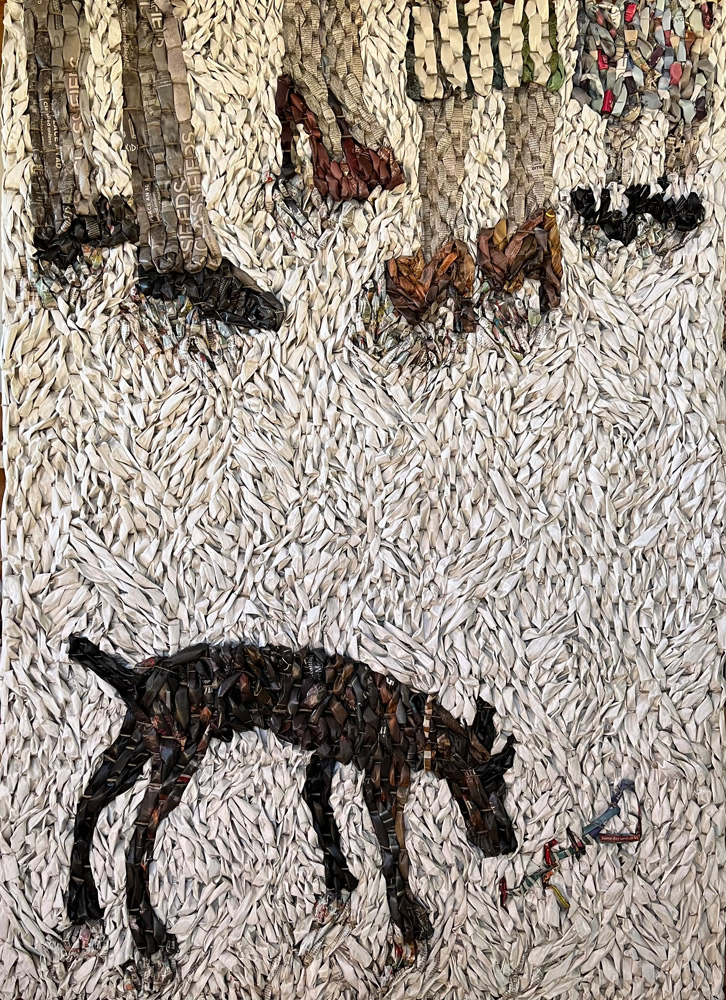
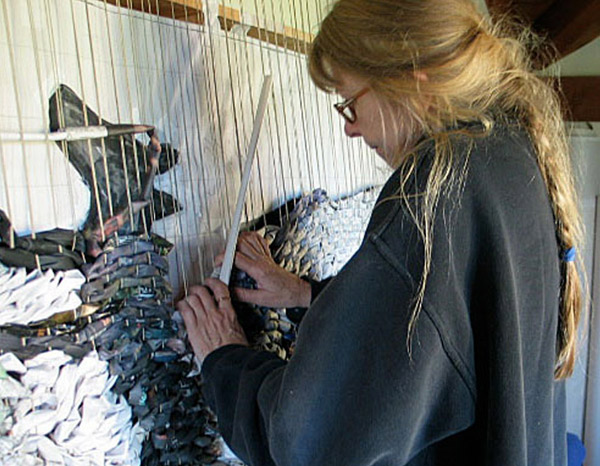 When I was a kid and rolled up sheets of newspaper and tied them into knots for kindling, little did I know that many decades later I would meet an artist who created portraits of Barack Obama, Bill Clinton and Crown Princess Mary of Denmark with rolled newspaper. Gugger Petter has done just that and shows her current work at Evoke.
When I was a kid and rolled up sheets of newspaper and tied them into knots for kindling, little did I know that many decades later I would meet an artist who created portraits of Barack Obama, Bill Clinton and Crown Princess Mary of Denmark with rolled newspaper. Gugger Petter has done just that and shows her current work at Evoke.
My parents bought what became our family home when I was 3. My mother had told her friends when she moved to Scituate, MA, that she would one day own that particular house. They laughed. After having married my father, had my brother and, 8 years later, me, my father charmed Annie Edson, the wonderful old Yankee lady who owned the house into selling it to them. Her stipulation was that she would live there until she died. She lived in the apartment on the second floor in the 1833 residence that she had run as an inn. Annie often took me by the hand and, carrying a basket, would have me pick up twigs in the yard that she would use for kindling in her fireplace.
My aunt would drop off the Sunday papers after early Mass and when we would later wander into the living room, Annie would be sitting there in my father’s chair reading the papers, dropping the pages around her on the floor. She taught me to roll the pages, make a knot, and she took them upstairs for additional kindling.
When Gugger moved to California 1986 she was intrigued by the way the sun yellowed newspapers and began to think about how she could use newspapers as a medium in her art. Its limited color palette and fragility posed a problem but she found if she rolled the paper into a tube and actually limited her palette to the colors available she had the building materials for making 3-D wall and floor sculptures.
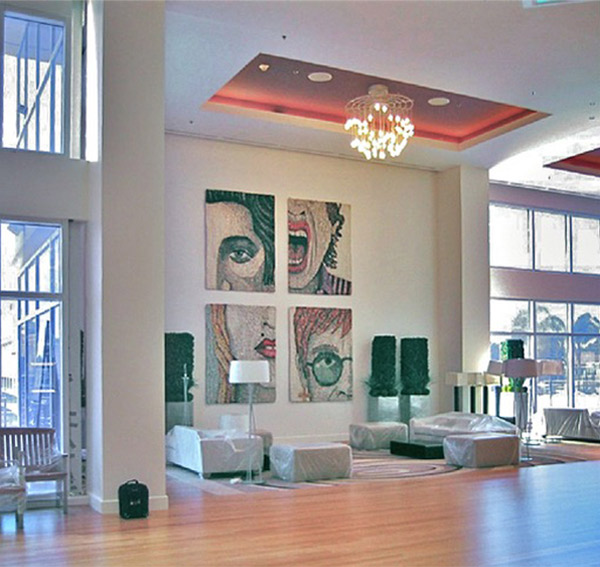 She had learned basic tapestry weaving in Mexico and adapted it to her own unique way of weaving the newspaper roles on a metal frame and varnishing it to make nearly indestructible compositions. They are so indestructible, in fact, that several survived the total destruction of the Hard Rock Hotel in Biloxi, MS, in Hurricane Katrina. When she saw video of the aftermath, on top of one of the piles of rubble was one of her 4 panels of rock stars that had been installed days before the grand opening that would never take place. When the hotel was rebuilt, Hard Rock dedicated a private space in the attic for relics of the disaster, including two of Gugger’s panels. The other two had floated out to sea.
She had learned basic tapestry weaving in Mexico and adapted it to her own unique way of weaving the newspaper roles on a metal frame and varnishing it to make nearly indestructible compositions. They are so indestructible, in fact, that several survived the total destruction of the Hard Rock Hotel in Biloxi, MS, in Hurricane Katrina. When she saw video of the aftermath, on top of one of the piles of rubble was one of her 4 panels of rock stars that had been installed days before the grand opening that would never take place. When the hotel was rebuilt, Hard Rock dedicated a private space in the attic for relics of the disaster, including two of Gugger’s panels. The other two had floated out to sea.
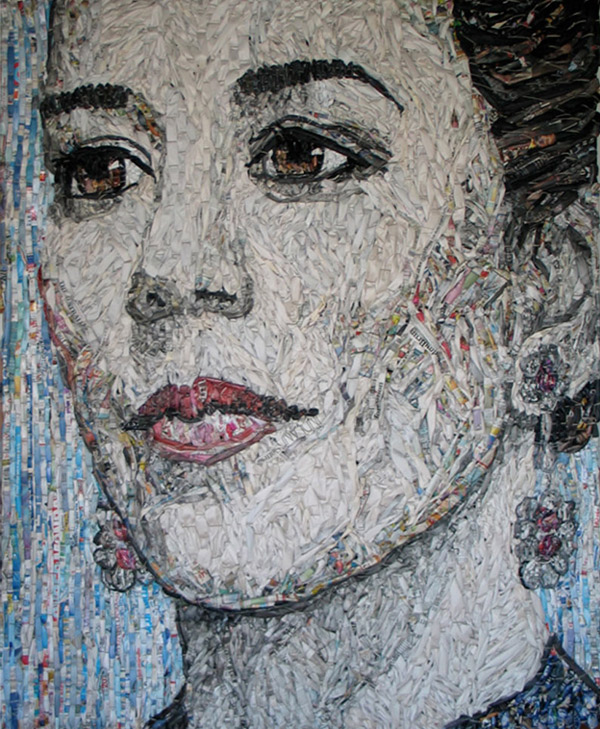 Lady Luck smiled on her after that, however, when, in 2007, her brother-in-law asked her to do a portrait of Barack Obama for his presidential campaign headquarters in Chicago. The ambassador of her native Denmark had seen the monumental portrait and asked later if he could borrow it for his official residence in Washington, DC. He kept asking for an extension of the loan and to thank her, invited her to lunch with Crown Princess Mary and Crown Prince Frederick of Denmark. (The couple are now king and queen.)
Lady Luck smiled on her after that, however, when, in 2007, her brother-in-law asked her to do a portrait of Barack Obama for his presidential campaign headquarters in Chicago. The ambassador of her native Denmark had seen the monumental portrait and asked later if he could borrow it for his official residence in Washington, DC. He kept asking for an extension of the loan and to thank her, invited her to lunch with Crown Princess Mary and Crown Prince Frederick of Denmark. (The couple are now king and queen.)
The Danish Museum of National History and Portrait Gallery in Frederiksborg Castle, asked Gugger for the loan of the Obama portrait. She suggested to the museum that it would be nice to have another portrait to go with it, telling them she would like to produce one of Crown Princess Mary. In 2012, Mary unveiled the portrait at the museum.
I lived briefly in northern Denmark when I studied at a photography school that promptly went bankrupt. Gugger asked if I can still speak Danish. I told her there is no “still” about it since I lived out in the country where the people have a heavy accent (which she acknowledged). I would practice what I needed to say when I went to get milk and eggs and gas for the hot water heater, but was then dead in the water. The Danish people were warm, welcoming and supportive, however, and often wanted to practice their English—especially the kids. It’s no surprise to me that these open-minded people would welcome a portrait made of newspaper of their soon-to-be queen into a national museum and that she would unveil it herself.
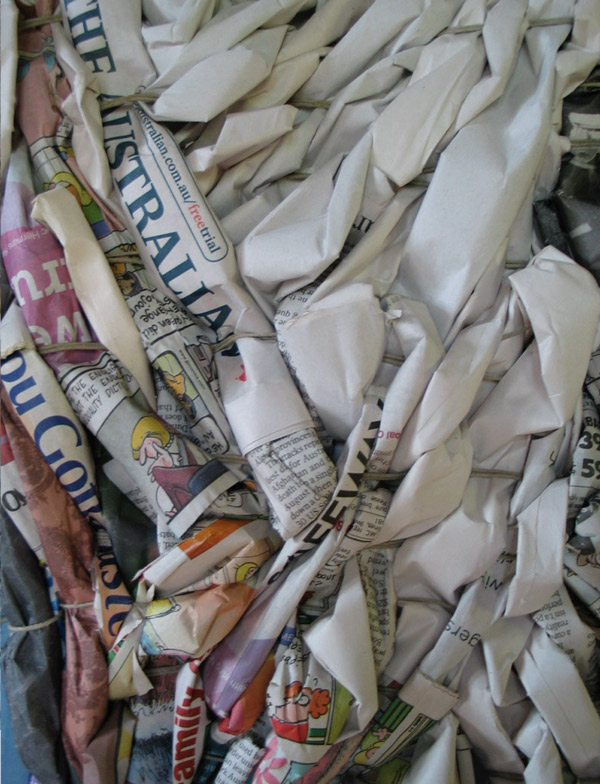 Given the complexity of her raw material and its assembly, I’m amazed by the subtleties she realizes in her portraits, especially this one of Queen Mary. She decided to face her subject toward the left, gazing into the future, using Danish newspapers on the left and newspapers from Mary’s native Australia on the right. She looked everywhere for Australian newspapers and eventually had to call the Danish embassy there to send her some—which they did, after a lot of convincing.
Given the complexity of her raw material and its assembly, I’m amazed by the subtleties she realizes in her portraits, especially this one of Queen Mary. She decided to face her subject toward the left, gazing into the future, using Danish newspapers on the left and newspapers from Mary’s native Australia on the right. She looked everywhere for Australian newspapers and eventually had to call the Danish embassy there to send her some—which they did, after a lot of convincing.
“As a child I loved going to museums,” Gugger says, “and this was my favorite museum. I always dreamed about living there--and today I do (a little bit) with my Mary work in permanent collection.”
Gugger no longer makes personalized portraits, concentrating now on enigmatic figurative compositions of people and animals. She describes them as embodying a “tension between opposites.” She controls the tension between positive and negative space, dark colors and light colors, detail and empty space, even energizing the space between male and female figures. Describing the latter, she says, “It’s not just a daily scene in a daily material. There’s much more behind it.”
“I find the informative aspect of newspaper quite important, “she says. “Since each piece I create holds all the world/local news of that particular time frame, it becomes an historic piece within itself. All artists date their oeuvre with great importance—reflecting their moment in time. My works not only hold a date, they also represent an historic documentation of our lives. This information may not be of importance to the viewer, but for me each piece becomes a diary.”
In Dog with 3 People and Child, a dog in the foreground occupies a negative space with no detail, contemplating an unknown object in front of him. Little bits of shadow ground the dog and the figures in the nebulous space. Gugger says, “The shoes and legs are arranged on the vertical and the background is totally chaos.”
“My works are usually monumental,” she explains. Dog with 3 People and Child is 62 by 45 inches. “You can see the totality of the work form a distance. Close up it transforms in a wonderful way into an abstraction. It can be viewed both ways. There is always ambiguity in my work. The story needs to be informed by the viewer. The subjects are anonymous. I need freedom when I work and I set the subjects free. Here we don’t know what kind of dog it is. It wears a collar so it belongs to someone but maybe not the people nearby.”
Dog with 3 People and Child invites us to wander visually around its surface, looking for details in the colored areas, enjoying the patterns in areas with no detail, and making up stories about the people and the dog, adding psychological tensions to the visual tensions, and having fun in the process.
View work by Gugger Petter ►

